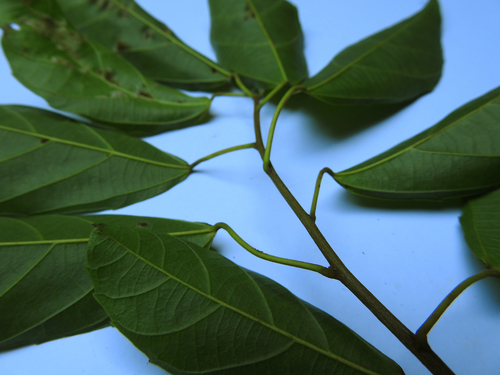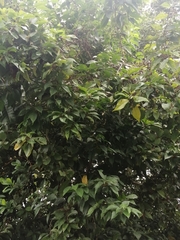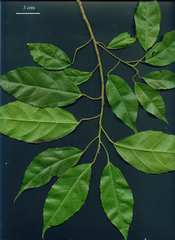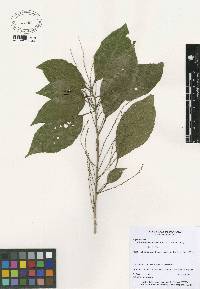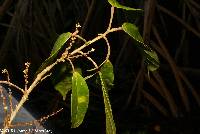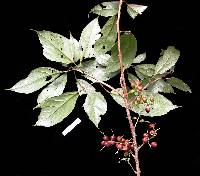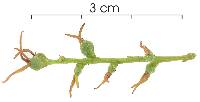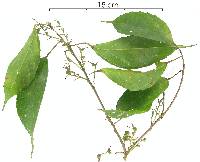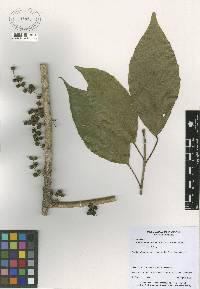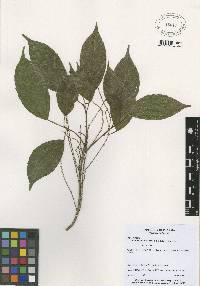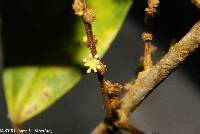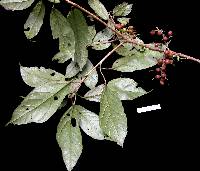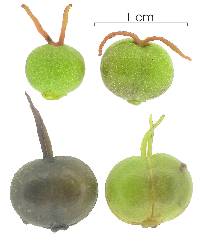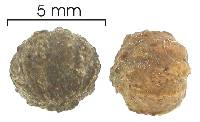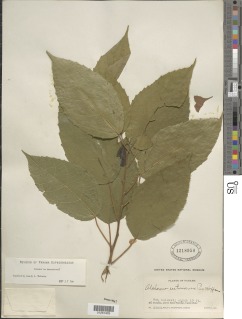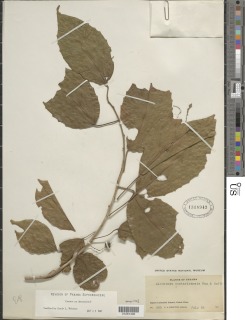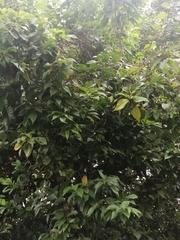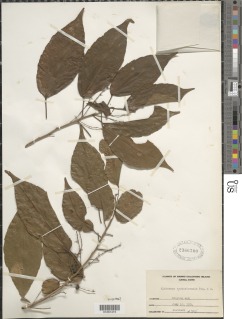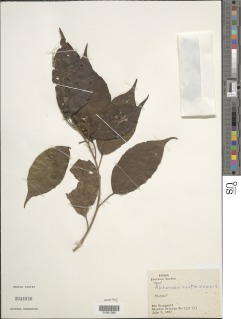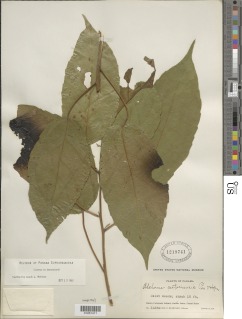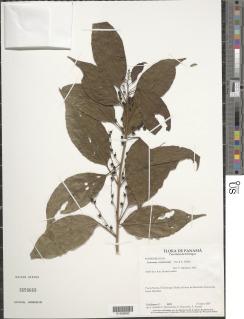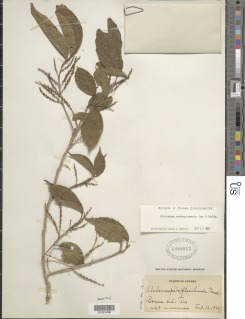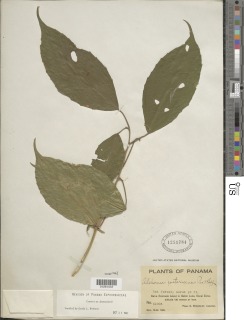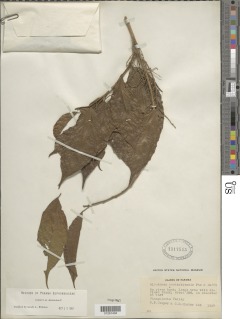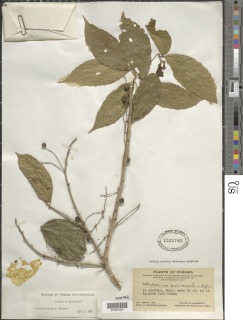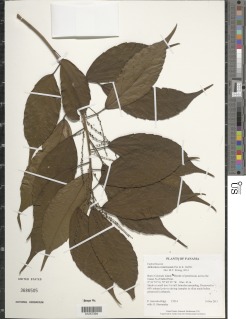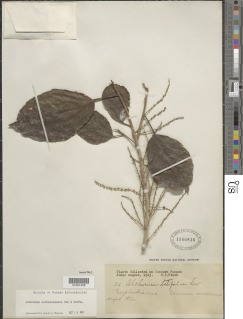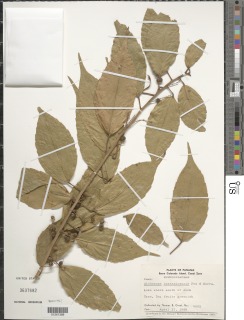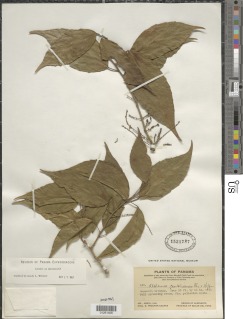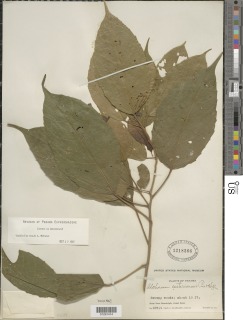

|
|
|
|
Family: Euphorbiaceae
nagua blanca
[Alchornea costaricensis f. longispicata Pax & K.Hoffm.] |
Description: A tall canopy tree. The trunk is generally somewhat fluted or irregular, and swells slightly at the base into small buttresses. Bark is light brown with black lenticels. Leaves are alternate, toothed, and held at an angle to the petiole, pointed at the tip but rounded toward the base. At the base of the leaf, on either side of and immediately adjacent to the petiole, are tiny circular glands, darker than the surrounding leaf. The base of the petiole is swollen. Reproduction: The white flowers are produced at the base of leaves, in March and April. The fruit is a two-lobed capsule, green than maturing brown from May to July; the flower's stigma remain visible at the apex of each fruit after maturity. Within the capsule are seeds covered with an edible red pulp. Distribution: Widespread in lowland forests near the Canal, especially toward the drier southern half of the isthmus, but always sparse. Probably prefers clearings in the forest, as saplings are rarely seen in old-growth, but not seen along roads or in open areas. Similar Species: This, the related LK alchla Alchornea latifolia LK2 and the unrelated LK hassfl Hasseltia floribunda LK2 all have similar leaves, with teeth and with small circular glands at the base of the leaf. In A. latifolia, the petiole is swollen at both ends (one end in A. costaricensis), and large trees of latifolia have browner bark. Hasseltia has ventation quite different from the Alchornea. Descripción: Árbol de 10 a 20 m de alto. Tronco con raíces tablares pequeñas en la base. Corteza exterior blanca o crema y con lenticelas negras. Hojas simples y alternas, de 8-15 x 3-6 cm, ovadas o elípticas, con ápice acuminado, bordes crenados y base obtusa. Las hojas presentan un par de glándulas en la base. Estípulas pequeñas y deciduas. Pecíolo de 1-4 cm de largo y pulvinado en la base. La especie es dioica. Inflorescencias axilares. Frutos en cápsulas bilobuladas, de 0.5-1 cm de diámetro, verdes, tornándose rojos al madurar. Los restos de los dos estigmas de la flor permanecen en la punta del fruto. Semillas con sarcotesta roja. Datos Ecológicos: La especie crece a bajas y medianas elevaciones, en bosques húmedos o muy húmedos. En Panamá se encuentra en las provincias de Bocas del Toro, Chiriquí, Coclé, Colón, Darién, Los Santos, Panamá y Veraguas. Florece y fructifica de marzo a julio. Especies Parecidas: A menudo se confunde con LK alchla Alchornea latifolia LK2 , pero en A. latifolia las hojas son más grandes y presentan de 2-4 glándulas en la base. LK hassfl Hasseltia floribunda LK2 tiene hojas muy parecidas, pero en H. floribunda los frutos son bayas pequeñas. Usos: La madera es empleada para fabricar cajones, tableros, aglomerados y en la producción de pulpa para papel. Dioecious tree, 5-15 m tall, usually less than 30 cm dbh; trunk often forming sucker shoots near base. Leaves alternate, simple; stipules inconspicuous, less than 0.5 mm long; petioles 1.5-3.5 (9) cm long, short-pubescent; blades elliptic or ovate-elliptic, long-acuminate, obtuse at base, 8-18 cm long, 3-6.5 cm wide, pinnately veined, 3-veined at base, minutely and sparsely stellate-pubescent below and on veins above, becoming glabrate, remotely crenate-dentate, with 2 foliar glands at base of blade. Spikes stellate-pubescent, the staminate axes unbranched, mostly 2-18 cm long, the pistillate spikes 2-8 (10) cm long; staminate flowers apetalous, subsessile, to 1.5 mm diam, clustered with 3 or 4 per bract; calyx lobes 3 or 4; stamens 7 or 8, in 2 series; filaments +/- equaling anthers, confluent with disk; pistillate flowers apetalous, solitary, densely pubescent; calyx 4-lobed to about midway; ovary ellipsoid, ca 1.5 mm long, densely pubescent; styles 2, more than twice length of ovary, usually persisting in fruit, simple, +/- divergent, 7-10 mm long; stigmatic surface glabrous. Capsules subglobose, green to brown, 2-valved, 5-7 mm long, 6.5-8.5 mm wide, the valves falling free at maturity to expose bright red seeds; seeds 2, 1 per carpel, ellipsoid, 4-6 mm long, displayed on the central columella, flattened on 1 side, the testa brown, irregularly tuberculate, covered with a bright red, thin, pulpy layer. Croat 10914, 14546, 14619. Frequent in the forest. Flowers from March to June, with the fruits maturing mainly from May to July. According to R. Foster (pers. comm.), individuals may flower twice in quick succession following the start of the rainy season. Flowers of the second wave are produced at the time the first fruits ripen. Costa Rica and Panama. In Panama, known from tropical moist forest in the Canal Zone, Bocas del Toro, Panama, and Darien. Bocas Species Database Natural History Notes: Wood used to make boxes, crates, boards and in making paper. Characteristics: Tree that reaches from 10 to 20 m in height. Recognized by its simple and alternate leaves. |
|
|
|

